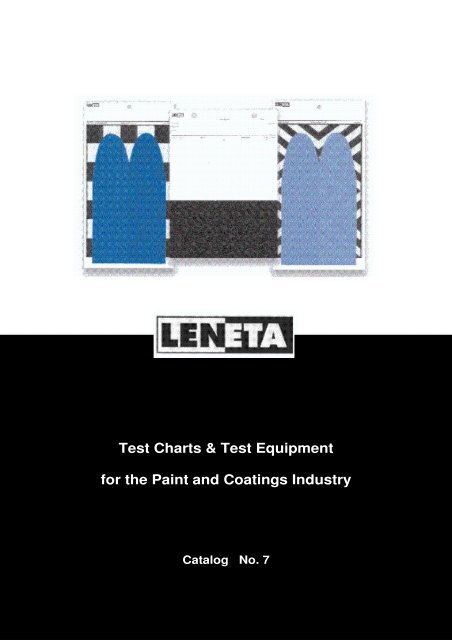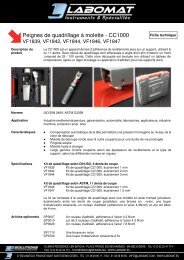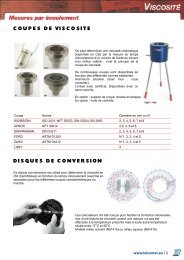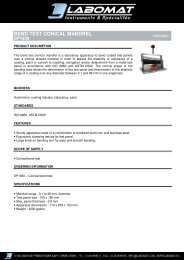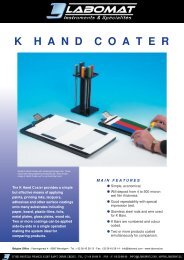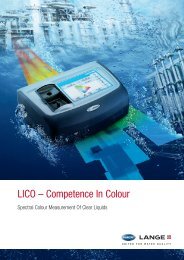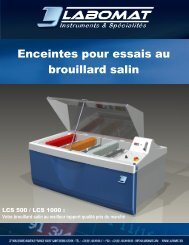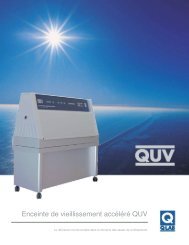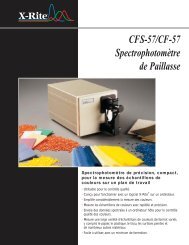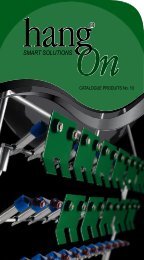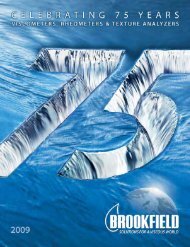Test Charts & Test Equipment for the Paint and Coatings ... - Labomat
Test Charts & Test Equipment for the Paint and Coatings ... - Labomat
Test Charts & Test Equipment for the Paint and Coatings ... - Labomat
You also want an ePaper? Increase the reach of your titles
YUMPU automatically turns print PDFs into web optimized ePapers that Google loves.
Opacity <strong>Charts</strong>The term “Opacity Chart”, as used in this catalog, refers to charts on which <strong>the</strong> test pattern is a simple combinationof black <strong>and</strong> white areas, large enough <strong>for</strong> wide aperture reflectance instruments, as well as <strong>for</strong> visual opacity <strong>and</strong>color observations. Leneta opacity charts comply with all test methods specifying charts of such design.Form 2A5-1/2 x 10 in140 x 254 mmForm 2C7-5/8 x 10-1/4 in194 x 260 mmForm 5C7-5/8 x 10-1/4 in194 x 260 mmForm 3B7-5/8 x 11-3/8 in194 x 289 mmPACKAGINGForm Box Boxes BoxNo. Quantity per Case Weight2A 250 6 6 lb2C 250 4 9 lb3B 250 4 9 lb5C 250 4 9 lb14H 125 4 11 lb15H 125 4 11 lbForm 15H11-1/4 x 17-1/4 in286 x 438 mmForm 14H11-1/4 x 17-1/4 in286 x 438 mmDesign Area = 1.076 ft 2 = 0.1 m 2 = 1000 cm 2Page 4
Penopac <strong>and</strong> Penetration <strong>Charts</strong>(Sealed)(Sealed)(Unsealed)Form 1A5-1/2 x 10 in140 x 254 mm(Sealed)(Unsealed)(Sealed)(Sealed)Form 18A5-1/2 x 10 in140 x 254 mmPenopac <strong>Charts</strong>These combine <strong>the</strong> test areas <strong>and</strong> functionsof a penetration <strong>and</strong> an opacitychart. They can be considered as universaltest charts <strong>for</strong> research, development<strong>and</strong> quality control. The choices offeredin size <strong>and</strong> design are responsive to individuallaboratory needs <strong>and</strong> preferences.Form 19BR includes an unsealed blackarea, but is o<strong>the</strong>rwise equivalent in functionality.(Sealed)(Sealed)(Unsealed)(Sealed)(Unsealed)(Sealed)(Sealed)(Unsealed)(Sealed)(Unsealed)(Sealed)(Sealed)Form 1B7-5/8 x 11-3/8 in194 x 289 mmForm 18B7-5/8 x 11-3/8 in194 x 289 mmForm 19BR7-5/8 x 11-3/8 in194 x 289 mmPenetration ChartAn important characteristic of architecturalfinishes is <strong>the</strong> ability to maintaina uni<strong>for</strong>m appearance on surfacesof varying porosity. This ability,of which gloss <strong>and</strong> color uni<strong>for</strong>mityare specific aspects, is referred to aspenetration resistance. The adjacentsealed/unsealed areas of LenetaForm HB present severe conditionsof varying porosity <strong>for</strong> testing penetrationresistance. In addition toqualitative visual observations, photometricmeasurements on <strong>the</strong> twoareas provide objective numericalvalues.(Sealed)(Unsealed)Form HB7-5/8 x 11-3/8 in194 x 289 mmPage 5PackagingForm Box Boxes BoxNo. Quantity per Case Weight1A 250 6 6 lb1B 250 4 9 lb18A 250 6 6 lb18B 250 4 9 lb19BR 250 4 9 lbHB 250 4 9 lb
Display <strong>Charts</strong> / Spreading Rate <strong>Charts</strong>These charts employ time-tested diagonally striped patterns, having a strong visual impact that emphasizes variationsin film opacity. They are <strong>the</strong>re<strong>for</strong>e frequently used <strong>for</strong> hiding power display purposes, by means of drawdowns orbrushouts. Gray stripes in Form 8H-GW provide reduced substrate contrast <strong>for</strong> use with low hiding power coatings.Spreading Rate <strong>Charts</strong> (Forms 8H <strong>and</strong> 8H-GW) are accurately 0.1 square meters (approximately one square foot) inarea, <strong>and</strong> are used in brushout hiding tests at specified spreading rates as described in ASTM Method D 344.Form 8A5-1/2 x 10 in140 x 254 mmDesign Area = 275 cm 2Form 8B7-5/8 x 11-3/8 in194 x 289 mmDesign Area = 425 cm 2Form 8K8-5/8 x 11-1/4 in219 x 285 mmDesign Area = 500 cm 2Spreading Rate <strong>Charts</strong>Design Area = 1.076 ft 2 (1000 cm 2 )PACKAGINGForm Box Boxes BoxNo. Quantity per Case Weight8A 250 6 6 lb8B 250 4 9 lb8H 125 4 11 lb8H-GW 125 4 11 lb8K 250 4 11 lbForm 8H11-1/4 x 17-1/4 in286 x 438 mmForm 8H-GW11-1/4 x 17-1/4 in286 x 438 mmPage 6
Opacity-Display <strong>Charts</strong> / Spreading Rate <strong>Charts</strong><strong>Charts</strong> of this type combine <strong>the</strong> large, unbroken areas that are characteristic of Opacity <strong>Charts</strong>, with <strong>the</strong> striped designof a Display Chart. The larger areas permit wide aperture photometric measurements <strong>and</strong> visual color comparisons,while <strong>the</strong> striped area is uniquely effective <strong>for</strong> hiding power comparison <strong>and</strong> display. Spreading Rate <strong>Charts</strong> (Forms12H <strong>and</strong> 13H) are accurately 0.1 square meters (approximately one square foot) in area, <strong>and</strong> are designed <strong>for</strong> brushoutapplication at specified spreading rates.Form 9A5-1/2 x 10 in140 x 254 mmForm 9B7-5/8 x 11-3/8 in194 x 289 mmForm 21B7-5/8 x 11-3/8 in194 x 289 mmSpreading Rate <strong>Charts</strong>Design Area = 1.076 ft 2 (1000 cm 2 )PackagingForm Box Boxes BoxNo. Quantity per Case Weight9A 250 6 6 lb9B 250 4 9 lb12H 125 4 11 lb13H 125 4 11 lb21B 250 4 9 lbForm 12H11-1/4 x 17-1/4 in286 x 438 mmForm 13H11-1/4 x 17-1/4 in286 x 438 mmPage 7
Checkerboard <strong>Charts</strong> / Spreading Rate <strong>Charts</strong>One of <strong>the</strong> earliest hiding power test surfaces was linoleum with a black <strong>and</strong> white checkerboard pattern. This wassoon replaced by sealed paperboard charts of which Forms 10H <strong>and</strong> 10H-BG Spreading Rate <strong>Charts</strong> are typicalexamples. Designed <strong>for</strong> brushout tests at specified spreading rates, such as in ASTM Method D 344 <strong>and</strong> Canadian1-GP-71, <strong>the</strong>y are also used <strong>for</strong> drawdown applications like <strong>the</strong>ir smaller counterparts, Forms 10A <strong>and</strong> 10B. Black<strong>and</strong> gray squares in Form 10H-BG provide reduced contrast <strong>for</strong> testing coatings with lower hiding power.PackagingForm Box Boxes BoxNo. Quantity per Case Weight10A 250 6 6 lb10B 250 4 9 lb10H 125 4 11 lb10H-BG 125 4 11 lbForm 10A5-1/2 x 10 in140 x 254 mmForm 10B7-5/8 x 11-3/8 in194 x 289 mmDesign Area = 275 cm 2 Design Area = 425 cm 2Spreading Rate <strong>Charts</strong>Design Area = 1.076 ft 2 (1000 cm 2 )Form 10H11-1/4 x 17-1/4 in286 x 438 mmForm 10H-BG11-1/4 x 17-1/4 in286 x 438 mmPage 8
Brushout Cards / Duplex Applicator <strong>Charts</strong>Plain White Cards / Plain White <strong>Charts</strong> / Plain Black ChartBrushout CardsNominal Thickness: 20 mils (0.5 mm)Designed <strong>for</strong> in<strong>for</strong>mal brushout applications,<strong>the</strong> paper stock is thicker than regular chartpaper to give greater rigidity <strong>for</strong> more convenienth<strong>and</strong>ling. They are also used widely<strong>for</strong> drawdowns <strong>and</strong> colorimetric measurements.Form Box Boxes BoxNo. Quantity per Case Weight2DX 500 4 7 lb5DX 500 4 7 lb5DX-GW 500 4 7 lbWDX 500 4 7 lbForm 2DXBlack & WhiteForm 5DX Form 5DX-GW Form WDXBlack & White Gray & White Plain WhiteSize: 3-7/8 x 6 inches (98 x 152 mm)Duplex Applicator <strong>Charts</strong>Originally made to be used with <strong>the</strong> “DuplexApplicator”, an instrument designed <strong>for</strong> rapidproduction of side-by-side drawdowns, <strong>the</strong>ynow serve mostly as generic paint testcharts.Form <strong>Charts</strong> Boxes BoxNo. per Box per Case Weight6F6 500 6 5 lb6F4 500 6 5 lbWF 500 6 5 lbForm 6F6Form 6F4Size: 3 x 7-1/4 inches (76 x 184 mm)Form WFPlain White CardsNominal Thickness: 20 mils (0.5 mm)Plain White <strong>Charts</strong>Nominal Thickness: 14 mils (0.36 mm)Plain Black <strong>Charts</strong>Nominal Thickness: 14 mils (0.36 mm)Form Size Box Boxes WeightNo. Inches Millimeters Quantity Per Case Per Box*WBX 7-5/8 x 11-1/4 194 x 286 125 4 7 lb*WDX 3-7/8 x 6 98 x 152 500 4 7 lbWKX 8-5/8 x 11-1/4 219 x 286 125 4 8 lbWHX 11-1/4 x 17-1/4 286 x 438 75 4 10 lb*WA 5-1/2 x10 140 x 254 250 6 6 lb*WB 7-5/8 x 11-1/4 194 x 286 250 4 10 lb*WD 3-7/8 x 6 98 x 152 1000 4 10 lbWF 3 x 7-1/4 76 x 184 500 6 5 lbWG 3 x 5-1/2 76 x 140 1000 4 8 lbWH 11-1/4 x 17-1/4 286 x 438 125 4 11 lbWK 8-5/8 x 11-1/4 219 x 286 250 4 11 lbWM 5-1/2 x 11-1/4 140 x 286 250 6 6 lbBK 8-5/8 x 11 219 x 279 250 4 11 lbBH 11-1/4 x 17-1/4 279 x 438 125 4 11 lb**B-3 5-5/8 x 32 143 x 813 200 -- 18 lb* Indicates convenience hole at top. ** Specified <strong>for</strong> Dupont <strong>Paint</strong>brush Evaluation <strong>Test</strong>Special sizes available upon request.Page 9
Unsealed <strong>Test</strong> <strong>Charts</strong>For <strong>Test</strong> Applicationsof Clear <strong>Coatings</strong><strong>and</strong> StainsUnsealed (semi-porous)surface simulateswood or unsealedwallboard.Form N2C7-5/8 x 10-1/4 in194 x 260 mmForm N2A5-1/2 x 10 in140 x 254 mmForm N9A5-1/2 x 10 in140 x 254 mmALSO: FORM NWK, Plain white -- Size: 8-5/8 x 11-1/16 in (219 x 281 mm)Wax <strong>and</strong> Polish<strong>Test</strong> ChartSuper-SmoothJet BlackVery Dull, Matte FinishForm WP-15-1/2 x 10 in140 x 254 mmPACKAGINGForm Box Boxes BoxNo. Quantity per Case WeightN2C 250 4 9 lbN2A 250 6 6 lbN9A 250 6 6 lbNWK 250 4 11 lbWP-1 250 6 6 lbPage 10
Release <strong>Charts</strong>For rapid <strong>and</strong> precise hiding power measurementsThese charts have a unique surface which is readily wetted by waterborne orsolventborne paints, but from which <strong>the</strong> dried film can easily* be stripped withadhesive tape. The stripping feature permits <strong>the</strong> dry film weight on a measuredarea to be determined precisely by weighing on an analytical balance be<strong>for</strong>e <strong>and</strong>after film removal. The spreading rate (H) <strong>and</strong> wet film thickness (T) can <strong>the</strong>n becalculated from <strong>the</strong> following simple relationships:H(m 2 /L)=A(cm 2 ) . N . D (kg/L)10 M(g)H(ft 2 /gal) = 40.746H(m 2 /L)H(ft 2 /gal) x T (mils) = 1604.2where: H = spreading rate (m 2 /L), (ft 2 /gal).T = wet film thickness (µm), (mils)A = test area (cm 2 )D = paint density (kg/L)M = dry film weight (g)N = non-volatile fraction by weight of <strong>the</strong> applied paintRC-BCThis procedure represents a break-through in reduced time <strong>for</strong> precise measurementof spreading rate (or wet film thickness) in <strong>the</strong> determination of hidingpower.RC-5C* Not so easily as to produce undamaged free films. For that purpose use Form RP-1Krelease paper described on page 20.Form Color Dimensions Box Boxes WeightQuantity Per Case Per BoxRC-5C Black & White 7-5/8 x 10-1/4 in 250 4 9 lb194 x 260 mmRC-BC All Black 7-5/8 x 10-1/4 in 250 4 9 lb194 x 260 mmPage 11
Gray Scale <strong>Charts</strong>For Visual Hiding Power RatingsLarge-Area Roller or Brush ApplicationForm CU-1M <strong>Test</strong> Area 6 ft 2 (5574 cm 2 ) 24 x 37-1/4 in (610 x 946 mm)Con<strong>for</strong>ms with ASTM D5150, Hiding Power of Architectural <strong>Paint</strong>s Applied by RollerThese are sealed paint test chartswith six stripes on a white field,ranging in shade from very lightgray to black. The stripes are numbered1 to 6, representing uni<strong>for</strong>msteps of increasing contrast. Thehiding power of <strong>the</strong> applied coatingsis rated as <strong>the</strong> number of <strong>the</strong>darkest stripe that is completely (oralmost completely) obscured, at aspecified thickness or spreadingrate. Form CU-1M is used <strong>for</strong> morepractical large-area brush or rollerapplications as in ASTM D 5150.Applications on Form 24B are witha drawdown blade. See Appendix,Page 33 <strong>for</strong> gray scale values.Drawdown ApplicationPACKAGINGForm Box Boxes BoxNo. Quantity per Case Weight24B 250 4 9 lbCU-1M 100 1 47 lbForm 24B7-5/8 x 11-3/8 in194 x 289 mmTypical Drawdown <strong>Test</strong>on Form 24BPage 12
Wall-Matte <strong>Charts</strong>Large-area matte finish test surfaces <strong>for</strong> practical laboratory application testing of wall paintsThese charts are coated with a flat finish similar in texture <strong>and</strong> “tooth” to a typical trade sales flat wall paint. <strong>Paint</strong>scan be applied by brush or roller with assurance that <strong>the</strong>re will be no surface “skid” during application. The surfaceis well sealed so that both waterborne <strong>and</strong> solventborne coatings can be applied with no penetration of vehicle into<strong>the</strong> substrate.Wall-Matte <strong>Charts</strong> are an effective replacement <strong>for</strong> previously available Kem-Glo <strong>Test</strong> Paper <strong>and</strong> superior to thatproduct in imperviousness <strong>and</strong> paper rigidity.Form 26-1M20 x 28 in508 x 711 mmArea: 3.9 ft 2 (0.36 m 2 )Form 26-2M28 x 40 in711 x 1046 mmArea: 7.8 ft 2 (0.72 m 2 )Physical DataThickness: 14 mils (300µm) approx.Reflectance: White 83±3%, Gray 46±3%60° Gloss: 2 approx.85° Gloss: 2 approx.PackagingForm Box BoxNo. Quantity Weight26-1M 125 34 lb26-2M 100 55 lbPage 13
Spray StripsHiding Power <strong>Charts</strong> <strong>for</strong> OEM <strong>Coatings</strong>These are used by industrial coatings laboratories, principally those involved with <strong>the</strong> automotive industry, to measure<strong>the</strong> hiding power of spraying enamels. The chart is attached to a steel panel <strong>and</strong> <strong>the</strong> test coating sprayed toproduce a “wedge” varying from thin at one end to thick at <strong>the</strong> o<strong>the</strong>r. After drying, a location on <strong>the</strong> chart of adequatevisual hiding or 0.98 contrast ratio is determined, <strong>and</strong> <strong>the</strong> film thickness measured electronically on <strong>the</strong> steel paneladjacent to that location. Conversely, a location of specified thickness is determined on <strong>the</strong> steel panel <strong>and</strong> <strong>the</strong>Contrast Ratio measured adjacent to that location.Size2 x 11 inches51 x 279 mmForm S71Form S71-BGForm S72Form S72-BGBlack & WhiteBlack & GrayBlack & WhiteBlack & GrayalsoForm S71-RGRed & GrayPACKAGING: 500 per box 4 boxes per case box wt. 5 lbPage 14
Spray MonitorsSelf-Adhering Hiding Power LabelsThese are pressure sensitive labels with a hiding power test pattern <strong>and</strong> a sealed, solvent-resistant surface. They areused primarily with metal panels on which <strong>the</strong> uni<strong>for</strong>m surface provides no visual clue as to <strong>the</strong> thickness of an appliedpaint film. When placed on such a surface, <strong>the</strong> Monitor presents a contrasting feature by which to observe <strong>the</strong> hidingduring spray application, <strong>the</strong>reby facilitating film thickness control. It adheres firmly, whe<strong>the</strong>r air-dried or baked,to present a permanent visual record of film opacity. The longer Monitors, M71 <strong>and</strong> M72, permit wedge application,with thickness <strong>and</strong> hiding power determination, as described with Spray Strips (see page 14).Size2 x 2 in51 x 51 mmSize1 x 1 in25 x 25 mmForm M33Black & WhiteALSOAVAILABLERed & GrayForm M12-RGForm M33-RGForm M12Black & WhiteForm M12-BGBlack & GraySize2 x 11 in51 x 279 mmForm M71Black & WhiteForm M71-BGBlack & GrayForm M72Black & WhiteForm M72-BGBlack & GrayPACKAGING: M12 2000 per box 4 boxes per case box wt. 2 lbM33 500 per box 4 boxes per case box wt. 2 lbM71, 72 500 per box 4 boxes per case box wt. 6 lbPage 15
Printing Ink Drawdown SheetsAvailable in seven different grades of paper, <strong>the</strong>se sheets provide a variety of substrates <strong>for</strong> testing ink qualities. They are also useful <strong>for</strong> testing o<strong>the</strong>r coatingbecause of <strong>the</strong>ir range in absorbancy <strong>and</strong> texture.Sheet Size: 5 x 7- 5/8 in (127 x 194 mm)Paper: Unwatermarked, non-fluorescentexcept as noted belowInk: Jet black. Non-bleedingPadding: 100 sheets per padPackaging: 1000 sheets (10 pads) per box 5Paper Description 1 <strong>and</strong> Form Number IdentificationForm Number 3NT-1 3NT-21 3NT-31 3NT-34 3NT-4 3NT-5 3NT-8 3NT-9 4Paper Type Vellum Translucent Coated Coated Regular Unbleached Web Offset BoxOpaque Bond 2 Book Book Bond Kraft Coated Laminatewith/OB 5 with/OB 5Shade Neutral Neutral Neutral NeutralBrownNeutral MottledWhite White White White White WhiteBasis Weight 3 60 lb 15 lb 80 lb 20 lb 40 lb 45 lb 125 lbGrammage (g/m 2 ) 89 56 118 75 65 67 203Caliper (mils) 5.0 2.5 3.7 3.9 4.0 2.5 10.0Caliper (µm) 127 64 94 99 102 64 254Density (g/cm 3 ) 0.70 0.89 1.26 0.76 0.64 1.05 0.80Boxes per case 5 6 6 6 5 6 4Box weight (lb) 6 4 8 5 5 5 3Notes:1. Indicated weights, densities <strong>and</strong> calipers are nominal <strong>and</strong>/or approximate.2. This paper is absorbent despite <strong>the</strong> high level of transparency3. Ream of 500 basis sheets.4. This is a laminate of white on brown kraft paper, representative of white corrugatedbox surfaces, <strong>and</strong> showing a typical mottled appearance. 500 sheets/box, unpadded.5. “OB” means Optical BrightenersClear Polyester Overlay SheetsSame Size as Printing Ink Drawdown SheetsForm No. ThicknessBox Boxes BoxQuantity Per Case WeightP300-4NT 4 mil (100 µm) 250 4 3 lbP300-7NT 7 mil (178 µm) 250 4 4 lbSee Page 19 <strong>for</strong> <strong>the</strong> complete range of available sizes <strong>and</strong> thicknesses.Page 16
Leneta Paper-<strong>Test</strong>ing InksFor Evaluating Mottle, Holdout <strong>and</strong> Porosityof Coated <strong>and</strong> Uncoated PapersItem No. TK-11 : High Penetration <strong>for</strong> Coated PapersItem No. TK-21: Low Penetration <strong>for</strong> Uncoated PapersThese testing inks provide a simple <strong>and</strong> rapid way of monitoring batch-to-batchvariations in paper structure <strong>and</strong> porosity. Inks of both high <strong>and</strong> low penetrationsare required because <strong>the</strong> penetration quality of <strong>the</strong> ink must be appropriate to <strong>the</strong>holdout of <strong>the</strong> paper surface being tested. Coated papers, being relatively highin holdout, require a high penetration ink to obtain a sufficiently strong color <strong>and</strong>mottle pattern. Uncoated papers, being low in holdout, require a low penetrationink to avoid excessively strong color that would overwhelm any mottle or holdoutdistinctions. Examples of test patterns obtained using <strong>the</strong> two inks, demonstrating<strong>the</strong>ir specialized nature, are as follows:TK-11TK-21Low Penetration InkTK-11TK-21Low Penetration InkTK-11High Penetration InkHigh Penetration InkCoated PapersUncoated Papers<strong>Test</strong> Procedure: Spread <strong>the</strong> ink on <strong>the</strong> paper to be tested using a spatula ordrawdown applicator (see TK-100 Applicator below). After one minute remove<strong>the</strong> ink by first scraping off most of it with a straight edge, <strong>the</strong>n wiping away<strong>the</strong> remainder carefully with a clean paper towel. The resultant test pattern ischaracterized visually <strong>for</strong> mottle <strong>and</strong> porosity. To obtain an instrumental value<strong>for</strong> porosity, measure <strong>the</strong> CIE-Y reflectances, or <strong>the</strong> densitometer values, of<strong>the</strong> stained <strong>and</strong> unstained areas, <strong>the</strong>n calculate:TK-21Porosity Index (Holdout) Y unstained - Y stained 10 ΔD -1==100 Y unstained 10 ΔDWhere D = densitometer value <strong>and</strong> Δ D = D stained - D unstainedPACKAGINGTK-11 118 mL (227 grams -- 1/2 lb) per jarTK-21 118 mL (151 grams -- 1/3 lb) per jar8 jars per caseItem No. TK-100: Applicator <strong>for</strong> Paper-<strong>Test</strong>ing InksTK-100Constructed of aluminum, this low cost applicator is designed specially <strong>for</strong> usewith Leneta <strong>Test</strong>ing Inks. One edge has a 10 mil (250 µm) clearance <strong>and</strong> appliesa 3 inch (75 mm) wide film. The opposite edge can be used as a convenientscraper.Dimensions: 5 in x 2 in x 1/8 in (127 mm x 51 mm x 3 mm)Page 17
Special SubstratesWood Panels - Birch: This type of hardwood is light in color with an attractivegrain, making it particularly suitable <strong>for</strong> color matching <strong>and</strong> demonstration of stains.Birch Plywood - 5/32 in (4 mm) thickR1AR7AR1DR7DForm Size Box Boxes WeightNo. inches mm Quantity Per Case Per BoxR1A 5-1/2 x 10 140 x 254 50 4 11lbR1D 3-1/2 x 6 89 x 152 100 4 9 lbAvailable on Request:R1-TA Designed <strong>for</strong> Taber Abraser: Size 4 x 4 in (100 x 100 mm) with 1/4 inch (0.6 mm) diameter center hole.Simulates hardwood flooring.R1-W For use in wea<strong>the</strong>rometers: Size 3 x 6 in (75 x 150 mm) .Birch Veneer - 1/32 in (0.7 mm) thickThis is real wood laminated to paper.Form Size Box Boxes WeightNo. inches mm Quantity Per Case Per BoxR7A 5-1/2 x 10 140 x 254 100 4 5 lbR7D 3 x 6 76 x 152 100 4 2 lbR6-1224Upson Board - Fiberboard PanelsR6-1218R6-912R6-612Fiberboard panels, 3/16 inch thick, provide a surface appropriate <strong>for</strong> test applications ofwall paint.Form Size Box WeightNo. inches mm Quantity Per BoxR6-612 6 x 12 152 x 305 150 40 lbR6-912 9 x 12 229 x 305 100 40 lbR6-1218 12 x 18 305 x 457 50 40 lbR6-1224 12 x 24 305 x 610 40 44 lbPage 18
Special Substrates - ContinuedP300-1KP300-2KP300-4CP300-7CP300-4NTP300-7NTP300-4GP300-7GClear PolyesterThis clear film can be used as a substrate <strong>for</strong> <strong>the</strong> application of a coating <strong>and</strong> viewed<strong>for</strong> transmitted appearance properties including color, gloss <strong>and</strong> transparency, orplaced over a black <strong>and</strong> white background <strong>for</strong> evaluation of hiding power. In addition,it is used as an overlay to protect a drawdown after drying, without obscuringvisibility.Form Thickness Size Box Boxes WeightNo. mils µm inches mm Quantity Per Case Per BoxP300-1K 1 25 8-1/2 x 11 216 x 279 125 4 1 lbP300-2K 2 50 8-1/2 x 11 216 x 279 125 4 1 lbP300-4C 4 100 7-5/8 x 10-1/4 194 x 260 125 4 3 lbP300-4G 4 100 3 x 5-1/2 76 x 140 250 4 2 lbP300-4NT 4 100 5 x 7-5/8 127 x 194 250 4 3 lbP300-7C 7 175 7-5/8 x 10-1/4 194 x 260 125 4 4 lbP300-7G 7 175 3 x 5-1/2 76 x 140 250 4 2 lbP300-7NT 7 175 5 x 7-5/8 127 x 194 250 4 4 lbIf you would like a size o<strong>the</strong>r than those shown above, please contact us <strong>for</strong> a quoteAAX-1PAAX-2NAGX-1PAGX-2NAlu-Cards - Aluminum foil laminated to paperboard panelsThese are low cost metallic substrates to replace expensive solid metal panelswhen <strong>the</strong> primary interest is in appearance. The test surface has a high metallicluster. The cards are 18 mils (0.46 mm) thick <strong>and</strong> have a 1 /4 inch (6.4 mm) diameterhole punched in one end. In addition to lower cost, a major advantage overregular metal panels is that <strong>the</strong>y are much lighter in weight <strong>and</strong> <strong>the</strong>re<strong>for</strong>e moreconveniently stored. See page 27 <strong>for</strong> Spray St<strong>and</strong> <strong>and</strong> Adapters used in sprayapplications on <strong>the</strong>se panels.Form Size Box Boxes WeightNo. inches mm Quantity Per Case Per BoxAAX-1P Primed 1 5-1/2 x 10 140 x 254 125 6 5 lbAAX-2N Unprimed 2 5-1/2 x 10 140 x 254 125 6 5 lbAGX-1P Primed 1 3 x 5-1/2 76 x 140 500 6 6 lbAGX-2N Unprimed 2 3 x 5-1/2 76 x 140 500 6 6 lb1. Clear organic primer <strong>for</strong> improved adhesion.2. Foil both sides <strong>for</strong> minimum bake distortion. Bright side is conductive.Page 19
Glass SubstratesBlacklite** Glass Panels - Approximately 0.25 inch (6mm) thickBlack glass is used in widely referenced high-precision ASTM Method D 2805, <strong>and</strong>related hiding power test methods. After measuring <strong>the</strong> reflectance R 0 of <strong>the</strong> dryfilm, a defined area is scraped from <strong>the</strong> glass <strong>and</strong> weighed to obtain <strong>the</strong> spreadingrate or original wet film thickness. R ∞ of <strong>the</strong> paint film is obtained from a separatetest application. The hiding power is <strong>the</strong>n calculated from <strong>the</strong> appropriate Kubelka-Munk equations found in <strong>the</strong> ASTM method.GB-2ABlack glass panels are used in U.S. Federal <strong>Test</strong> Method 141-4122 <strong>and</strong> CGSBMethod 1-GP-71-14.7 <strong>for</strong> measuring hiding power. The latter method also provides<strong>for</strong> direct wet film thickness measurements using a Pfund or Interchemical type ofwet film thickness gage, as described in ASTM Method D 1212.These methods depend on <strong>the</strong> unique hardness <strong>and</strong> levelness characteristics ofglass substrates. Leneta black glass is much superior in levelness to previouslyavailable striated types.Black Size Box WeightUnstriated - BlackliteQuantity Per BoxGB-2BItem No. GB-2A 8 x 8 in 1 2 lb200 x 200 mmItem No. GB-2B 8 x 12 in 1 3 lb200 x 300 mm** Blacklite: Refers to <strong>the</strong> Leneta type of black glassNOTE: Although visually not as opaque as true Carrara Glass, Blacklite Glass has atransmission of less than 1%, making it an adequate substitute <strong>for</strong> Carrara Glass.Release PaperRelease Paper - For preparing free films of organic coatingsThis paper is sealed on both sides, one side glossy <strong>and</strong> <strong>the</strong> o<strong>the</strong>r matte. The glossyside has a silicone finish with balanced release, to avoid excessive crawling of solventborneor waterborne coatings, while permitting easy stripping of dried films. Itis recommended in ASTM D 4708 “St<strong>and</strong>ard Practice <strong>for</strong> Preparation of Uni<strong>for</strong>mFree Films of Organic <strong>Coatings</strong>” <strong>and</strong> can be used to prepare test films <strong>for</strong> ASTM D2370 “Tensile Strength of Organic <strong>Coatings</strong>”, ASTM D 1653 “Water VaporTransmission of Organic <strong>Coatings</strong> Films”, <strong>and</strong> o<strong>the</strong>r free-film test methods.RP-1KForm Size Thickness Box Boxes WeightNo. Quantity Per Case Per BoxRP-1K 8-5/8 x 11-1/4 in219 x 286 mm5 mil127 µm250 4 8 lbPage 20
The TG19 Logicator TMItem TG19: A Geometric-Sequence Multi-Notch Applicator,designed <strong>for</strong> rapid visual hiding power measurements.Con<strong>for</strong>ms with ASTM Method D 5007, Wet-to-Dry HidingChange.TG19Description: This unique drawdown blade applies aseries of stripes with thicknesses in equal percentagesteps, to permit single-drawdown exploration of <strong>the</strong> widestpracticable application range. In addition to <strong>the</strong> hidinglevel of <strong>the</strong> coating, it also facilitates examination of <strong>the</strong>effect of film thickness on drying speed <strong>and</strong> surface uni<strong>for</strong>mity,allowing a quick characterization of <strong>the</strong> essential featuresof <strong>the</strong> coating. The individual stripes are identifiedby “INDEX” numbers (20 to 48) engraved on <strong>the</strong> instrument,<strong>and</strong> also printed on <strong>the</strong> Form 23B Logicator Chartdesigned <strong>for</strong> use with this applicator. The Index Numbersare in equal numerical steps corresponding to incrementsof approximately 20% in notch clearance, film thickness<strong>and</strong> spreading rate, as shown in <strong>the</strong> following table:INDEX NUMBER20 24 28 32 36 40 44 48WET FILM THICKNESS (W.F.T.)*milsµm5.71454.71203.9983.2812.6672.2551.8451.537NOTCH CLEARANCEmils 10.40 8.56 7.04 5.79 4.76 3.92 3.23 2.65µm 264 217 179 147 121 100 82 67SPREADING RATE*ft 2 /gal 280 341 414 504 612 744 904 1100m 2 /L 6.9 8.4 10.2 12.4 15 18 22 27* Based on W.F.T. = 55% of Notch Clearance<strong>Test</strong> Procedure: After <strong>the</strong> applied coating has dried, <strong>the</strong>operator locates <strong>the</strong> critical stripe, visually or photometrically,<strong>and</strong> encircles <strong>the</strong> parameter of interest, as illustrated.It is generally accepted that <strong>the</strong> hiding power endpointis not total visual extinction, but a degree of contrastjust short of complete hiding, corresponding to a photometriccontrast ratio of 0.98.ASTM D 5007: In this st<strong>and</strong>ard, <strong>the</strong> hiding power of <strong>the</strong>wet film <strong>and</strong> <strong>the</strong>n of <strong>the</strong> dry film are observed visually, <strong>and</strong><strong>the</strong> percentage increase or decrease is reported.PACKAGINGForm 23B Logicator Chart -Typical DrawdownChart Size: 7-5/8 x 11-3/8 in (194 x 289 mm)Stripe Width: 0.7in (17.8 mm) Overall Film Width: 6 in (152 mm)Item Box Boxes BoxQuantity Per Case WeightTG19 1 -- 1 lb23B 250 4 9 lbPage 21
Leneta Scrub <strong>Test</strong> PanelsForm P121-10NBlack Plastic-Vinyl Chloride/Acetate CopolymerSmooth Matte Surface - Plasticizer FreeThickness: 10 mils (0.25 mm) - Size: 6-1/2 x 17 in (165 x 432 mm)Used in ASTM D 2486, ASTM D 4213, ISO 11918 <strong>and</strong> O<strong>the</strong>r Scrub <strong>Test</strong> MethodsIn a typical scrub test, <strong>the</strong> coating is applied to <strong>the</strong> Leneta Scrub <strong>Test</strong> Panel at a specified filmthickness, allowed to dry, <strong>the</strong>n subjected to scrubbing with a straight-line scrub tester. In ASTMD 2486, a 10 mil shim is inserted under <strong>the</strong> panel to accelerate failure <strong>and</strong> <strong>the</strong>reby reduce testingtime. The scrub resistance is <strong>the</strong> number of scrub cycles required to remove <strong>the</strong> coating toa specified end point.Alternatively, <strong>the</strong> loss in weight is determined after a specified number of scrub cycles as ameasure of scrub resistance, with calculation of equivalent loss in film thickness.Form P121-10NFig. 1 Typical Failure Using Shim per D2486, Method A.Fig. 2 Typical Failure Without ShimThe above photographs show actual tests of latex flat paints. Note that <strong>the</strong> films have worn downto a fea<strong>the</strong>r edge, with no sign of adhesion failureALSO AVAILABLE: WHITE SCRUB TEST PANELS - FORM P122-10NUsed with dark colored paints <strong>for</strong> contrast. Same physical properties as Form P121-10N.PACKAGING: 100 per box, 5 boxes per case.Leneta Calibration Scrub <strong>Test</strong> PanelsForm P121-AForm P121-CPoor Scrub Resistance Good Scrub Resistance* 80 cycles-to-failure * 400 cycles-to-failure* Typical Values per ASTM D2486, Method AThese are st<strong>and</strong>ard panels prepared by applying white emulsion paints on black scrub testpanels. The films are indefinitely stable <strong>and</strong> <strong>the</strong> panels of each type essentially identical. Theyare used as controls in <strong>the</strong> measurement of scrub resistance, to obtain Calibration Ratings thatnormalize <strong>the</strong> wide variations often encountered <strong>for</strong> undefined reasons, among laboratoriesusing <strong>the</strong> same scrub method. The Calibration Rating is <strong>the</strong> per<strong>for</strong>mance of <strong>the</strong> test paintpanel expressed as a percentage relative to that of <strong>the</strong> selected Calibration Panel. Thus:% Calibration Rating =<strong>Test</strong> Panel Cycles-to FailureCalibration Panel Cycles-to-Failurex 100 **** The letter indicating <strong>the</strong> calibration panel type is appended to <strong>the</strong> calibration rating, e.g. 125A, 65C, 95C etc.Form P121-A & CThe figure to <strong>the</strong> left illustrates simultaneous side-by-sidescrubbing of half-panels to maximize correlation, analogousto ASTM D 2486, Method B.Calibration PanelNOTE: See also ASTM D 4213 “Weight Loss Method” whereby:<strong>Test</strong> <strong>Paint</strong> PanelCalibration Panel Weight LossCalibration Rating =x 100<strong>Test</strong> Panel Weight LossPACKAGING: 3 per box, 4 boxes per case.Page 22
Leneta- ASTM Scrub <strong>and</strong> Staining MediaLeneta-ASTM Scrub MediaNon-Abrasive TypeItem No. SC-1Used in ASTM Method D3450,<strong>Test</strong> <strong>for</strong> Washability Properties.Abrasive TypeItem No. SC-2Used in ASTM Method D2486, D4213 <strong>and</strong> D3450,Scrub Resistance <strong>and</strong> Washability <strong>Test</strong>s.SC-1SC-2These are aqueous dispersions of detergent, cellulosic thickener <strong>and</strong> preservative, made in con<strong>for</strong>mance with <strong>and</strong>approved <strong>for</strong> use in <strong>the</strong> indicated ASTM methods. The abrasive type contains ground silica <strong>for</strong> accelerated erosion. Thetwo compounds are representative of <strong>the</strong> detergent <strong>and</strong> abrasive character of commercial cleaning products. Becauseof <strong>the</strong> variable nature of <strong>the</strong>ir ingredients, Leneta Company provides media adjusted <strong>and</strong> tested to assure batch-tobatchuni<strong>for</strong>mity. Each container is fully identified by batch number <strong>and</strong> shipping date. The contents of unopened containersare guaranteed st<strong>and</strong>ard in per<strong>for</strong>mance <strong>for</strong> a year, which is highly conservative on <strong>the</strong> basis of observed packagestability.Supplied in pint (473 mL) jars, sufficient <strong>for</strong> about 40 tests.Weight per jar: 2 lb, 8 jars per caseLeneta-ASTM Staining MediaPigmented TypeItem No. ST-1Used in ASTM Method D 3450,<strong>Test</strong> <strong>for</strong> Washability PropertiesThis is a finely ground dispersion of high jet carbon blackin a blend of mineral oil <strong>and</strong> odorless mineral spirits. It isspecified in ASTM D3450 to meet <strong>the</strong> laboratory requirement<strong>for</strong> a reproducible composition of matter, representativein a general way of soilants encountered in <strong>the</strong> field.Penetrating Dye TypeItem No. ST-31Recommended <strong>for</strong> ASTM Method D 3258,<strong>Test</strong> <strong>for</strong> Stain Resistance <strong>and</strong> PorosityThis is a proprietary composition of pigment <strong>and</strong> darkcoloreddye dispersed in an organic liquid vehicle.When applied <strong>and</strong> <strong>the</strong>n removed from a paint film, <strong>the</strong>intensity of <strong>the</strong> resultant stain indicates <strong>the</strong> degree offilm porosity. ST-31 is more effective than o<strong>the</strong>r mediarecommended <strong>for</strong> this purpose.ST-1ST-31Both media have perfect package stability <strong>and</strong> are manufactured <strong>and</strong> control tested to assure batch-to-batchuni<strong>for</strong>mity. Their usefulness extends not only to ASTM tests, but to any soil <strong>and</strong> stain removal test procedure.Supplied in 4 fl.oz. (118 mL) cans or jars.Weight per jar: 1/2 lb, 4 jars per casePage 23
Leneta Anti-Sag MeterUSED IN ASTM D4400, TEST METHOD FOR SAG RESISTANCE OF PAINTSThis is a drawdown blade with a series of notches of successively higher clearance. The notch clearance is related to<strong>the</strong> degree of sagging <strong>and</strong> provides a numerical value referred to as <strong>the</strong> Anti-Sag Index. The higher <strong>the</strong> Anti-Sag Index<strong>the</strong> better <strong>the</strong> sag resistance of <strong>the</strong> coating. The development of this instrument <strong>and</strong> its versatility <strong>for</strong> control <strong>and</strong> researchhave been described in published reports. 1.2 The Anti-Sag Meter is called <strong>for</strong> in ASTM 3 <strong>and</strong> Federal 4 test methods <strong>and</strong> isessential equipment in paint laboratories in <strong>the</strong> U.S.A. <strong>and</strong> throughout <strong>the</strong> world. Fig. 2 shows a typical test obtained withthis applicator. See Appendix (page 35) <strong>for</strong> test method details.1. Official Digest (JCT), October 1962 3. ASTM Method D 44002. Official Digest (JCT), January 1964 4. U.S. Fed, No. 141 Method 4494ASM-4Fig.1 - The Medium Range Anti-Sag MeterFig. 2 - Typical <strong>Test</strong> PatternThis test was made with <strong>the</strong> Medium Range Anti-Sag Meter.The test surface is a Form 7B Sag & Leveling Chart.Anti-Sag Meters Available From StockItem No. Range For Coating Type:ASM-1 St<strong>and</strong>ard Solventborne ArchitecturalASM-2 Low Industrial O.E.M. <strong>Coatings</strong>ASM-3 High High Build <strong>Coatings</strong>ASM-4 Medium Waterborne ArchitecturalNotch Clearances *mils 3 4 5 6 7 8 9 10 11 12µm 78 100 125 150 175 200 225 250 275 300mils 1 1.5 2 2.5 3 3.5 5 4.5 5 5.5 6µm 25 38 50 63 75 88 100 113 125 138 150mils 14 15 18 20 25 30 35 40 45 50 60µm 350 400 450 500 625 750 875 1000 1125 1250 1500mils 4 6 8 10 12 14 16 18 20 22 24µm 100 150 200 250 300 350 400 450 500 550 600* Mils are exact. Wet film thickness is about half of <strong>the</strong> clearance.Sag <strong>and</strong> Leveling <strong>Test</strong> ChartThis <strong>for</strong>m was designed <strong>for</strong> use with <strong>the</strong> Leneta Anti-Sag Meter <strong>and</strong> finds additional use with <strong>the</strong> Leneta Leveling <strong>Test</strong>Blade (see page 25). Its special characteristic is <strong>the</strong> provision of an applicator path with a considerable length of blackin <strong>the</strong> middle. Thus by making test observations only over <strong>the</strong> black area, <strong>the</strong>re is automatic compliance with instructionsto ignore <strong>the</strong> leading <strong>and</strong> trailing edges of <strong>the</strong> drawdown. See <strong>the</strong> Appendix (page 35).PACKAGINGForm Size Box Boxes WeightNo. Quantity Per Case Per Box7B 7-5/8 x 11-3/8 in.(194 x 289 mm) 250 4 9 lb.Page 24
Leneta Leveling <strong>Test</strong> Blade <strong>and</strong> St<strong>and</strong>ardsUsed in ASTM D 4062, <strong>Test</strong> <strong>for</strong> Leveling of <strong>Paint</strong>sFig. 1 The Leneta Leveling<strong>Test</strong> BladeFig. 2 Details from <strong>the</strong> engineering drawing.Dimensions are in millimeters. Plastic armsare illustrated in Fig. 1 above.Fig. 3 Drawdown Levelness St<strong>and</strong>ards underoblique light, as described in ASTM D 4062.Fig. 4 Application with <strong>the</strong> Leneta Leveling <strong>Test</strong> Blade.Illustrates use of Drawdown Plate <strong>and</strong> Catch-Papers.Leneta Leveling <strong>Test</strong> BladeItem No. LTB-2This is a threaded stainless steel rod that functions as agrooved doctor blade at any part of its circumference. Itproduces a film with parallel ridges <strong>and</strong> valleys in simulation ofbrush marks. Critical dimensions are indicated in <strong>the</strong> diagram.Plastic arms in conjunction with straight-edge guides assurerectilinear drawdown movement (see DP-2 Leveling <strong>Test</strong>Drawdown Plate below). Advantages over brushout applicationtests are speed, reproducibility, <strong>and</strong> a regular surface patternthat facilitates evaluation. The leveling of films applied in thismanner correlates well with brushout leveling.The diagram shows alternating clearances of 300 <strong>and</strong> 100 µm(12 <strong>and</strong> 4 mils), to apply alternate stripes of 150 <strong>and</strong> 50 µm (6<strong>and</strong> 2 mils) thickness. Thus <strong>the</strong> mean wet film thickness of <strong>the</strong>test drawdown will be about 100 µm (4 mils), corresponding toa spreading rate of 10 m 2 /L (400 ft 2 /gal).The detailed method is described in <strong>the</strong> Appendix, Page 35.Leneta Drawdown Levelness St<strong>and</strong>ardsItem No. LS-2These are 3-dimensional true scale replicas of drawdownsmade with <strong>the</strong> Leneta Leveling <strong>Test</strong> Blade, using a series ofnine paints ranging from extremely poor to good leveling. Theprimary st<strong>and</strong>ards are durable metal plates from which replicasare pressed in <strong>the</strong> <strong>for</strong>m of 3 x 5 in (75 x 125 mm) white vinylpanels. They are numbered 1 through 9 from poorest to bestleveling. Perfect leveling is 10 <strong>and</strong> poorer than 1 is zero.Evaluation of drawdowns prepared with <strong>the</strong> Leneta Leveling<strong>Test</strong> Blade is readily accomplished by visual comparison inoblique light. The number of <strong>the</strong> matching st<strong>and</strong>ard is <strong>the</strong>Leveling Value of <strong>the</strong> paint. Fur<strong>the</strong>r in<strong>for</strong>mation with regard to<strong>the</strong> significance of <strong>the</strong>se values is provided in <strong>the</strong> Appendix,Page 35.Leveling <strong>Test</strong>Drawdown PlateItem No. DP-2This drawdown plate wasdesigned <strong>for</strong> use with <strong>the</strong>Leneta Leveling <strong>Test</strong> Bladein ASTM Method D 4062. Itsconstruction features includeedge guides, to assure thatstraight parallel stripes areobtained from <strong>the</strong> rapid blademovement called <strong>for</strong> in <strong>the</strong>test method. It also includespeg stops that automaticallyterminate <strong>the</strong> blade movementin <strong>the</strong> correct locationat completion of <strong>the</strong> drawdown.“Catch-Papers”Form CP-2These are thin lacqueredsheets, size 3 x 7-1/4 in, <strong>for</strong>catching surplus paint at <strong>the</strong>end of <strong>the</strong> drawdown. This<strong>for</strong>m was designed specifically<strong>for</strong> use with <strong>the</strong> Leveling <strong>Test</strong>Drawdown Plate, being cut tosize <strong>and</strong> hole punched accurately<strong>for</strong> that purpose.Packaging: 1000 sheets/boxPage 25
Metopac (Metal) Panels<strong>Paint</strong>ed Steel Panels <strong>for</strong> Measuring <strong>the</strong> Hiding Powerof Powder <strong>Coatings</strong> <strong>and</strong> Industrial EnamelsT12MBlack Surface: Solvent resistant, Non-bleeding, Reflectance - 1% maximum*White Surface: Solvent Resistant, Color Retentive, Reflectance - 80% minimum** Measured using ASTM Method E 1347FormBox Boxes WeighColor Area** SizeNo. Quantity Per Case Per BoT12G Black & White 100 cm 2 3 x 5-3/16 inch 125 4 8 lb76 x 132 mmT12M Black & White 368 cm 2 5-3/16 x 11 inch 50 4 4 lb132 x 279 mm**Allowing <strong>for</strong> 1/4 inch (6mm hole.)T12GMajor uses include:ASTM Method D 6441 -- Measuring <strong>the</strong> Hiding Power of Powder <strong>Coatings</strong> -- Awedge shape film is applied on a T12G or T12M panel. Points of specified film thicknessare located over <strong>the</strong> black <strong>and</strong> white areas, reflectances are measured <strong>and</strong> <strong>the</strong>mean contrast ratio at that film thickness is calculated. Alternatively, severalblack/white pairs of equal-thickness points at various film thicknesses are located,<strong>and</strong> <strong>the</strong> calculated contrast ratio plotted graphically against <strong>the</strong> film thickness toobtain <strong>the</strong> film thickness at a contrast ratio of 0.98. In this method <strong>the</strong> reflectanceis measured with a small diameter aperture (e.g. 4 mm), <strong>and</strong> <strong>the</strong> film thickness withan electronic film thickness gage.Powder <strong>Coatings</strong> Institute Method -- In this method <strong>the</strong> film thickness is determineddirectly on a T12G panel at 0.98 Contrast Ratio. Alternatively, <strong>the</strong> Contrast Ratio isdetermined at a specified film thickness. Reflectance <strong>and</strong> film thickness instrumentationare as in ASTM D 6441.ASTM Method D 2805 -- Hiding Power of <strong>Paint</strong>s by Reflectometry --The film is applied uni<strong>for</strong>mly over a panel. The filmweight <strong>and</strong> reflectance R 0are determined on <strong>the</strong> black area, <strong>and</strong> <strong>the</strong> reflectivity R of <strong>the</strong> coating determinedusing <strong>the</strong> black <strong>and</strong> white areas. The gravimetric spreading rate at0.98 Contrast Ratio is <strong>the</strong>n calculated using Kubelka-Munk equations.Conversion to volumetric spreading rate or to film thickness is readilyaccomplished.8Page 26
Metal Panel AccessoriesItem SS-1 Magnetic Spray St<strong>and</strong>Laboratory spray st<strong>and</strong>s are often unsteady devices, thickly coated with overspray.The Leneta Magnetic Spray St<strong>and</strong> provides stability, tidiness, <strong>and</strong> generalconvenience. Its design is simple: two small but powerful pot magnets are mountedat one end of a curved steel rod. The o<strong>the</strong>r end of <strong>the</strong> rod is screwed into aheavy steel base. Overall height is approximately 13 inches. Steel panels 6 x 12inches <strong>and</strong> larger are held firmly during spraying <strong>and</strong> <strong>the</strong>n easily removed. Themagnets remain clean, being protected from overspray by <strong>the</strong> panel. O<strong>the</strong>r partsof <strong>the</strong> device are readily cleaned by soaking in paint remover or caustic solution.SS-1Box WeightItem No.Quantity Per BoxSS-1 1 11 lbAlu-Card AdapterThe magnetic spray st<strong>and</strong> can be used with Alu-Cards (see page 19) or o<strong>the</strong>r nonmagneticpanels by employing one of <strong>the</strong> steel adapters designed <strong>for</strong> that purpose.It provides a small peg from which <strong>the</strong> Alu-Card hangs, steadied by sidearms to prevent <strong>the</strong> card from blowing off in <strong>the</strong> spray stream. It is available intwo sizes, corresponding to <strong>the</strong> st<strong>and</strong>ard sizes in which Alu-Cards are supplied.PackagingItem Use With SizeInches MillimetersAD-1 Size A Cards 5-1/2 x 10 140 x 254AD-2 Size G Cards 3 x 5-1/2 76 x 140Page 27
Applicators - Blade TypeAlso referred to as “Drawdown Bars” or “Doctor Blades”, <strong>the</strong>y apply a wet filmthickness approximately half <strong>the</strong>ir gap clearance. They are essential laboratoryequipment <strong>for</strong> making uni<strong>for</strong>m <strong>and</strong> reproducible applications on Leneta <strong>Charts</strong><strong>and</strong> o<strong>the</strong>r surfaces.AT-686Trade Sales Applicators ("U"-Shape)Each of <strong>the</strong>se instruments has a 6 mil <strong>and</strong> an 8 mil gap clearance, laying downwet film thicknesses of approximately 3 <strong>and</strong> 4 mils, respectively. These are <strong>the</strong>thicknesses most often recommended <strong>for</strong> <strong>the</strong> testing of solventborne <strong>and</strong> waterbornearchitectural coatings, hence <strong>the</strong>ir characterization by Leneta as "TradeSales" applicators. The film widths of 4 <strong>and</strong> 6 inches take advantage of <strong>the</strong> mostpopular Leneta test chart widths of 5-1/2 <strong>and</strong> 7-5/8 inches. Their "U"-shapestructure retains a substantial volume of test coating to assure completeness ofdrawdowns.Film Gap Wet Film SpreadingItem Width Clearances Thickness Rate(mils) (mils) (ft 2 /gal)AT-684 4 in 6 3 5358 4 400AT-6866 in6 3 5358 4 400AD-710Dow Film CasterThis Applicator was originally designed <strong>for</strong> latex paint scrub test procedures ona 6-1/2 x 17 in. glass surface, in which a 3-1/2 mil thick test coat is applied overa 5 mil primer. Although <strong>the</strong> use of primed glass in tests of this type has beenlargely discontinued, <strong>the</strong> applicator continues to be widely used <strong>for</strong> its individualclearances.Film Gap Wet Film SpreadingItem Width Clearance Thickness Rate(inches) (mils) (mils) (ft 2 /gal)AD-7105-1/4 7 3-1/2 4605-1/2 10 5 320AB-86Bird ® ApplicatorsBird Applicators are specified by <strong>the</strong>ir film width <strong>and</strong> <strong>the</strong> approximate wet filmthickness <strong>the</strong>y are intended to apply. The latter value is engraved at one endof <strong>the</strong> applicator. To calculate <strong>the</strong> approximate spreading rate in square feet pergallon, divide 1604 by <strong>the</strong> indicated wet film thickness.Direction of MovementFilmWet Film Thickness*Width 2 mils 3 mils 4 mils 6 mils2 in AB-42 AB-62 AB-82 ---3 in AB-43 AB-63 AB-83 ---3.5 in AB-435 AB-635 AB-835 AB-12356 in AB-46 AB-66 AB-86 AB-1206* Approximately half <strong>the</strong> gap clearance.Page 28
Vacuum PlateVP-0912Vacuum Plate - per<strong>for</strong>atedThis is a flat, per<strong>for</strong>ated aluminum plate, with a 9 x 12 inch surface, on whichhiding power charts <strong>and</strong> o<strong>the</strong>r flexible surfaces may be placed <strong>and</strong> held flatduring application of coatings. The surface is large enough to accommodateall Leneta chart sizes up to 8-5/8 x 11-1/4 inches. A vacuum pump or sourceof laboratory vacuum is required.Item Size WeightVP-0912 9 x 12 x 2 in 6 lb227 x 305 x 51 mmPage 29
Leneta Drawdown PlatesLeneta drawdown plates consist of a glass clipboard set firmly on a phenolicplastic panel <strong>and</strong> mounted on rubber bumpers to prevent sliding while in use.The drawdown surface is 6 mm (1/4 inch) thick polished glass, equal in planarityto fine mirror glass. A steel clip holds <strong>the</strong> test chart or panel steady while<strong>the</strong> drawdown is made. These devices provide economical <strong>and</strong> convenientmeans <strong>for</strong> making drawdowns of uni<strong>for</strong>m film thickness. They are easy to use,easy to keep clean, <strong>and</strong> extremely helpful in every paint <strong>and</strong> coatings laboratory.Item DP-1Leneta Drawdown Plate - RegularFor general use with Leneta <strong>Charts</strong> <strong>and</strong> panelsGlass Surface: 9 x 15 in (230 x 380 mm)DP-1Item DP-3 Leneta Scrub <strong>Test</strong> Drawdown PlateFor drawdowns on Leneta Scrub <strong>Test</strong> Panels, size 6-1/2 x 17 inches.Glass surface: 7 x 20 in (178 x 508 mm)In<strong>for</strong>mation on Leneta Scrub <strong>Test</strong> Panels can be found on page 22.DP-3Adjustable Straight EdgesThese devices are designed <strong>for</strong> mounting on Leneta Drawdown Plates asguides to assure rectilinear movement of <strong>the</strong> applicator. Lateral position isadjustable to accommodate various applicator widths.Item For Use OnSE-1 DP-1 St<strong>and</strong>ard Drawdown PlateSE-3 DP-3 Scrub <strong>Test</strong> Drawdown PlateDrawdown procedure usingstraight-edge <strong>and</strong> catch-paper.Form CP-1 Catch-PapersThese are thin, sealed papers that are placed under <strong>the</strong> bottom edge of a chartor panel to catch <strong>the</strong> surplus paint at <strong>the</strong> completion of a drawdown. The sealedsurface facilitates clean-up.PackagingForm Size Box Boxes WeightQuantity Per Case Per BoxCP-1 3 x 8-1/2 in 1000 4 4 lb75 x 215 mmPage 30
Leneta Wire-CatorsUsed to Apply Controlled Film Thickness Drawdowns of Liquid <strong>Coatings</strong>Also known as: Wire-Bar Applicators, Mayer RodsGeneral Description: Wire-Wound RodsWC-212Typical Drawdown with a Wire-CatorSet of 12 Wire-Cators on Bench St<strong>and</strong>Characteristics of Leneta Wire-Cators1. Wire Diameters: 2.5-75 mils (0.064-1.9 mm), provides wet film thicknesses: 0.18-6 mils (4.5-150 µm)2. Length of winding: 10 inches (254 mm). Sufficiently long to coat most st<strong>and</strong>ard size panels <strong>and</strong> charts.3. Length of rod: 12 inches (305 mm). Provides an inch (25 mm) clear <strong>for</strong> grasping at each end.4. Diameter of rod: 1/2 inch (12.7 mm). Thick enough to provide essentially perfect rigidity.5. Composition: All stainless steel. No rust or corrosion, even with waterborne coatings. Non-magnetic,permits use with steel panels on a magnetic chuck.Wire-Cators Available from StockWireFilmCatalog Diameter Thickness**Item No. mils* mm mils µmWC-2.5 2.5 0.064 0.18 4.5WC-3 3 0.075 0.2 5WC-4 4 0.10 0.3 8WC-6 6 0.15 0.4 10WC-8 8 0.20 0.5 13WC-10 10 0.25 0.65 16WC-12 12 0.30 0.8 20WC-14 14 0.36 0.95 24WC-16 16 0.41 1.1 28WC-18 18 0.46 1.25 32WC-20 20 0.51 1.4 35CatalogWireDiameterFilmThickness**Item No. mils* mm mils µmWC-22 22 0.56 1.5 38WC-24 24 0.61 1.7 42WC-26 26 0.66 1.8 47WC-28 28 0.71 2.0 50WC-30 30 0.76 2.2 55WC-32 32 0.81 2.3 59WC-34 34 0.86 2.5 63WC-36 36 0.91 2.7 68WC-38 38 0.97 2.8 72WC-40 40 1.02 3.0 75WC-42 42 1.07 3.2 81WireFilmCatalog Diameter ThicknessItem No. mils* mm mils µmWC-44 44 1.12 3.3 85WC-46 46 1.17 3.5 89WC-48 48 1.22 3.7 93WC-50 50 1.27 3.8 98WC-52 52 1.32 4.0 10WC-55 55 1.40 4.2 10WC-60 60 1.52 4.5 11WC-65 65 1.65 5.0 12WC-70 70 1.78 5.5 13WC-75 75 1.91 6.0 15* Exact** ApproximateIncluded in st<strong>and</strong>ardset of 12 Wire-Catorsreferred to below.Item No. WC-212: St<strong>and</strong>ard Set of 12 Wire-Cators <strong>and</strong> Bench St<strong>and</strong>Page 31
Non-Stick Inter-Leaf PapersLeneta Inter-Leaf Papers are thin, specially treated, non-stick sheets that protect your test chart applications frombeing marred by <strong>the</strong> effects of residual tack.When stacking, shipping or storing test charts, insert Leneta Inter-Leaf Papers between <strong>the</strong> charts.Available from stock - packed 1000 sheets per box - in <strong>the</strong> following st<strong>and</strong>ard Leneta Chart sizes:Size A Size C Size B Size KForm IP-1A5-1/2 x 10 in140 x 254 mmForm IP-1C7-5/8 x 10-1/4 in194 x 260 mmForm IP-1B7-5/8 x 11-1/4 in194 x 286 mmForm IP-1K8-5/8 x 11-1/4 in219 x 286 mm<strong>Paint</strong>-Out Starter KitItem PSK-1Low cost, entry level kit <strong>for</strong> making commercial quality drawdowns. Designed <strong>for</strong> facilities such as paint stores <strong>and</strong>small labs, where experience with uni<strong>for</strong>m film application is minimal. This kit provides all items needed to makepaint-outs at practical film thicknesses, <strong>for</strong> samples or <strong>for</strong> testing. The kit includes <strong>the</strong> following individual items:Item DP-4 Drawdown Plate, aluminum, 9 x 14-1/2 inches, <strong>for</strong> providing asmooth level support surface.Form WB Sealed, white drawdown charts, 7-5/8 x 11-1/4 in, box of 250,as a st<strong>and</strong>ardized surface, impervious to waterborne or solventbornepaints.Form CP-PSK Catch-Papers, 3 x 8-1/2 in, pad of 250 sheets, to be placedunder <strong>the</strong> bottom edge of <strong>the</strong> drawdown chart to catch <strong>the</strong>excess paint at <strong>the</strong> completion of a drawdown.Item WC-46Wire-Cator TM Applicator, 12 in long, 1/2 in diameter, wirewound rod, <strong>for</strong> applying a uni<strong>for</strong>m coating of about 3-1/2 milswet film thickness, equivalent to about 450 square feet pergallon, appropriate <strong>for</strong> both solventborne <strong>and</strong> waterbornepaints.Page 32
Contents1. Characteristics of charts <strong>and</strong> cards2. CIE-Y Reflectance of grays3. U.S. - Metric Conversions4. Spreading Rate <strong>and</strong> Film Thickness5. Equations <strong>for</strong> Spreading Rate <strong>Charts</strong>6. Film Constants7. Porosity by Saturant Absorption8. Basic Hiding Power Methods9. Kubelka-Monk (K-M) Equations10. Sag Resistance Method (D 4400)11. Leveling <strong>Test</strong> Method (D 4062)12. Pre-Shear <strong>Equipment</strong>13. Leneta in ASTM Methods1. Characteristics of <strong>Charts</strong> <strong>and</strong> CardsLiquid seal: Applied to one side only;solvent resistant; non-migrating.Black areas: Printed one side only;non-bleeding, reflectance 1% max. 1(< 2% on non-sealed charts.)Sealed White areas:Color retentive; non-fluorescentReflectance 1,4 <strong>Charts</strong>: 80 - 83%Cards: 80% minThickness 2 : <strong>Charts</strong> - 14 mils (0.35 mm)Cards - 20 mils (0.5 mm)Weightage 2 : Poundage Grammagelb/Mft 2 g/m 2<strong>Charts</strong>: 63 308Cards: 74 361Hole Punching 3 :One hole - 1/4 inch (6 mm) diameterTwo holes - 3/8 in (9.5 mm) diameter,4-1/4 in (108 mm) between centers.1Measured per ASTM E 1347, 0/45° geometry2Approximate3Indicated by illustrations or in <strong>the</strong> text.4Special higher brightness (87-89%)available onrequest: Forms 2A-H, 3B-H, 5C-H, 1B-H, WB-H2. CIE-Y Reflectances of GraysForm G%5DX-GW 46±38H-GW 46±310H-BG 34±3M * 31±3S * 31±326-1M, 26-2M 46±324B, CU-1M: Stripes#1 76 approx.#2 73 approx.#3 65 approx.#4 45 approx.#5 24 approx.#6 4 approx.* Represents additional letters <strong>and</strong>/or numbers toidentify two or more related products.Appendix3. U.S. - Metric ConversionsLength:1 in = 2.54 cm = 25.4 mm1 mil = 25.4µm1 mm = 39.37 mils1 ft = 30.48 cm = 0.3048 mArea: 1 in 2 = 6.4516 cm 21 ft 2 = 929.0304 cm 21 m 2 = 10.76391 ft 2Volume: cc ~ cm 3 ~ mL; L~ dm 31 in 3 = 16.387064 mL1 ft 3 = 28.3168 L= 7.48052 gal1 gal = 231 in 3 = 128 fl oz= 3785.412 mL1 fl oz = 29.5735 mL1 gal (Imperial)= 1.20095 gal (U.S.)Weight: 1 lb = 453.59237 g1 av oz = 28.3495 gDensity: 8.3454 lb/gal = 1 g/mL = 1 kg/LSpreading Rate:40.746 ft 2 /gal = 1 m 2 /L4.8824 ft 2 /lb = 1 m 2 /kgWeightage (Weight/Area):Poundage (lb/Mft 2 ) x 4.8824 =Grammage (g/m 2 )Temperature:°F =1.8 x °C +32°C = 5/9 (°F -32)4. Spreading Rate <strong>and</strong> Film Thickness*4.1 Metric Unitsa) H(m 2 /L) x T(µm) = 1000b) H(m 2 /L) x t(µm) = 1000 ND/dc) H(m 2 /kg) x T(µm) = 1000/D(kg/L)d) H(m 2 /kg) x t(µm) = 1000N/d(kg/L)4.2 U.S. Unitsa) H(ft 2 /gal) x T(mil) = 1604.2b) H(ft 2 /gal) x t(mil) = 1604.2ND/dc) H(ft 2 /lb) x T(mil) = 1604.2/D(lb/gal)d) H(ft 2 /lb) x t (mil) = 1604.2N/d(lb/gal)4.3 Dry vs Wet Film Thicknessa) ND = N V db) t = N V Tc) td = NTDWhere:H = spreading rate (whole paint)T = wet film thicknesst = dry film thicknessD = whole paint densityd = dry film densityN = non-volatile fraction by weightN V = non-volatile fraction by volume* non-porous filmsPage 335. Equations <strong>for</strong> Use With LenetaSpreading Rate <strong>Charts</strong>Laboratory operations in grams <strong>and</strong> mL.<strong>Test</strong> area is 1000 cm 2 (1.0764 ft 2 ).5.1 Metric Unitsa) V(mL) = T(µm) ÷ 10b) V(mL) = 100 ÷ H(m 2 /L)c) M(g) = T(µm) x D(g/mL) ÷ 10d) M(g) = 100 D(g/mL) ÷ H(m 2 /L)e) M(g) = V(m/L) x D(g/mL)**5.2 Mixed Unitsa) V(mL) = T(mils) x 2.54b) V(mL) = 4074.6÷ H(ft 2 /gal)c) M(g) = 488 x D(lb/gal) ÷ H(ft 2 /gal)** valid <strong>for</strong> any test area.Where: T = wet film thicknessV = volume appliedH = spreading rateM = weight appliedD = paint density6. Film Constantsby Direct MeasurementN V = 1 -D N =D B =D(1-N)D VD V NDD V +ND-1P = D N-D BD NWhere:D = wet density (g/cm 3 )N = non-volatile fraction by weightD V = density of volatiles (g/cm 3 )solventborne = 0.78waterborne = 1.00w = dry grammage (g/m 2 )t = dry film thickness (µm)N V = non-volatile fraction by volumeD N = dry displacement density (g/cm 3 )D B = dry bulk density (g/cm 3 )P = film porosity (voids/bulk)7. Porosity by Saturant AbsorptionP =QP =Q+RWhere:D N = dry displacement density (g/cm 3 )D S = saturant density (g/cm 3 )Q = saturant weight/film weightR= D S / D Nw tQD NQD N +D S
8. Basic Hiding Power Methods8.1 Definitions - Hiding Power isdefined as <strong>the</strong> Spreading Raterequired <strong>for</strong> full hiding over a st<strong>and</strong>ardblack <strong>and</strong> white substrate. The latter isspecified in coatings technology tohave CIE-Y reflectances of 0.01 (1%)max. <strong>and</strong> 0.80 (80%) respectively.Sometimes substrates with o<strong>the</strong>rshades or color combinations areemployed.When a film is applied uni<strong>for</strong>mly over ablack & white substrate, <strong>the</strong> ratio of <strong>the</strong>CIE-Y reflectance over <strong>the</strong> black areato that over <strong>the</strong> white area is itsContrast Ratio. Contrast Ratio is <strong>the</strong>photometric measure <strong>and</strong> statement of<strong>the</strong> film Opacity or Hiding.Full hiding <strong>for</strong> visual observationsmeans just short of total extinction ofcontrast. Photometrically it is definedas 0.98 Contrast Ratio.Appendix (continued)8.2 General Procedure - The objectiveis to determine <strong>the</strong> spreading rate at aspecified level of dry film opacity, asperceived visually or corresponding toa specified contrast ratio: C= R 0 /R 0.80 .The basic experimental procedure is toapply a uni<strong>for</strong>m film on a suitable testsubstrate, to observe its opacity ei<strong>the</strong>rvisually or photometrically, <strong>and</strong> todetermine its spreading rate. Since itis not possible to apply a film with precisionat a predetermined dry opacity,several such applications need to bemade over a range of spreading rates<strong>and</strong> <strong>the</strong>ir results plotted graphically.The spreading rate is <strong>the</strong>n taken from<strong>the</strong> graph at <strong>the</strong> specified ContrastRatio.Conversely, <strong>the</strong> Contrast Ratio can bedetermined on <strong>the</strong> same graph, at aspecified Spreading Rate or FilmThickness.8.3 Spreading Rate (or Film Thickness)Determination - In both visual <strong>and</strong> photometrichiding power methods, <strong>the</strong>procedures <strong>for</strong> observing film opacityare well defined <strong>and</strong> can be per<strong>for</strong>medwith dispatch. The experimental taskthat is most dem<strong>and</strong>ing on <strong>the</strong> operator’stime <strong>and</strong> ingenuity is to determine<strong>the</strong> spreading rate or film thickness of<strong>the</strong> applied coating with good precision.Although gages are available <strong>for</strong>measuring wet <strong>and</strong> dry film thicknessdirectly, it is more accurate to determine<strong>the</strong> weight of dry paint film on ameasured test area <strong>and</strong> <strong>the</strong>n to calculate<strong>the</strong> spreading rate or film thicknessfrom one of <strong>the</strong> following equations:H(m 2 L)= 1000(1)T(µm) = A(cm2 ) • N • D(kg/L)10M(g)H(m 2 /kg)=1000Nt(µm) d(kg/L) •where:H = spreading rateT = wet film thicknesst = dry film thicknessA = test areaN = non-volatile fraction by weightD = paint densityd = dry film densityM = dry film weightMetric values thus calculated can beconverted to U.S. common units via<strong>the</strong> following relationships:H(ft 2 /gal = 40.746 H(m 2 /L) (3)H(ft 2 /lb) = 4.8824 H(m 2 /kg) (4)T(µm) = 25.4 T(mils) (5)D(lb/gal) = 8.3454 D(kg/L) (6)Powder coatings are usually consideredto be volatile-free, <strong>and</strong> <strong>the</strong>ir dry film <strong>and</strong>powder displacement densities (d <strong>and</strong> D)equal. In that case Equation 2 becomes:1000•This less rigorous equation avoids <strong>the</strong>need to determine d or N.9. Kubelka-Monk (K-M) Equations9.1 ASTM D 2805Using equations derived from K-M <strong>the</strong>ory,it is possible to calculate <strong>the</strong> contrast ratioof a coating at one spreading rate (or filmthickness) from measurements made atano<strong>the</strong>r. On that basis several easy <strong>and</strong>accurate hiding power test methods havebeen developed, one being <strong>the</strong> widelyreferenced ASTM D 2805. The equationsare complex, requiring computer solutions,but <strong>the</strong> experimental measurementsare minimal. Consult <strong>the</strong> ASTMmethod <strong>for</strong> full details.9.2 Calculations of R , ReflectivityThis basic optical property of a coating isdefined as “<strong>the</strong> reflectance of a film thickenough to be completely opaque”. Fewcoatings applied at normal film thicknesshide completely. Kubelka-Monk <strong>the</strong>oryprovides equations <strong>for</strong> calculating Rfrom measurements on non-opaque filmsapplied uni<strong>for</strong>mly on black <strong>and</strong> white hidingpower charts, as follows:8Page 34•= A(cm2 ) N10M(g)H(m 2 /kg)=t(µm) D(kg/L) = ) A(cm210M(g)(2)(7)8a = 1 2(R W +R 0 + W - R WWR 0)8R = a-(a 2 -1) 1/2Where:R 0 = reflectance over black substrateW = white substrate reflectanceR W = reflectance over white substrate9.3 White Substrate VariationFor hiding power control purposes, coatingsare applied on a black & white substrateat a st<strong>and</strong>ard film thickness,reflectances R O <strong>and</strong> R W are measured,<strong>and</strong> <strong>the</strong> Contrast Ratio R O /R W calculated.With non-opaque films, variations inwhite substrate reflectance can affect <strong>the</strong>measured value of R W , <strong>and</strong> <strong>the</strong>re<strong>for</strong>e <strong>the</strong>contrast ratio hiding power criterion. Thefollowing Kubelka-Monk equation providesa solution to this problem, thus:R W -R G = (W-G)(R W-R 0 )W(1-GR 0 )Where:R 0 , W, R W are as stated above.G = alternate white substratereflectanceR G = reflectance over alternate whitesubstrateNote: G could be higher or lower than W
10. Leneta Anti-Sag MeterASTM Method D 4400A. <strong>Equipment</strong>(1) The Anti-Sag Meter, Page 24(2) Adjustable Straight Edge, Item SE-1(3) Drawdown Plate-Regular, Item DP-1(4) Drawdown <strong>Charts</strong> *Form 7B Black <strong>and</strong> white, <strong>for</strong> lightcolored paints.Form WB plain white, <strong>for</strong> darkcolored paints.(5) Catch-Papers, Form CP-1(6) Pre-shear equipment, Page 36* With <strong>the</strong> Low Range Anti-Sag Meter,a flat glass surface is preferred.B. Preparation of Coating(1) Stir well <strong>and</strong> adjust to 23°C (73.5°F)(2) Pre-shear in accordance with one of <strong>the</strong>methods described on Page 36, <strong>and</strong> testimmediately <strong>the</strong>reafter.C. Application of Coating(1) Attach <strong>the</strong> straight-edge to <strong>the</strong> drawdownplate in a suitable position.(2) Place a test chart on <strong>the</strong> drawdown plateunder <strong>the</strong> clip.(3) Place <strong>the</strong> Anti-Sag Meter on <strong>the</strong> chart adjacentto <strong>the</strong> clip, with its open side toward <strong>the</strong>operator <strong>and</strong> its shoulder against <strong>the</strong> straightedge.(4) Position <strong>the</strong> Catch-Paper.(5) Place a suitable quantity (8 - 10 mL) of preshearedpaint directly in front of <strong>the</strong> blade, <strong>and</strong>drawdown uni<strong>for</strong>mly at about 6 inches (150mm) per second.(6) Promptly fasten <strong>the</strong> drawdown to a verticalsurface, with stripes horizontal like rungs in ast<strong>and</strong>ing ladder, left edge (thinnest stripe) at <strong>the</strong>top, <strong>and</strong> allow to dry in that position.D. Rating <strong>the</strong> Drawdown(1) Note <strong>the</strong> notch numbers marked on <strong>the</strong>Anti-Sag Meter <strong>and</strong> identify <strong>the</strong> correspondingstripes accordingly.(2) Ignore <strong>the</strong> leading <strong>and</strong> trailing edges, <strong>and</strong>observe only <strong>the</strong> central 5-1/2 inches (150 mm)of blade path, corresponding to <strong>the</strong> black areaof Form 7B.(3) The lowest (thickest) stripe that does nottouch <strong>the</strong> one below itself is referred to as <strong>the</strong>index stripe, <strong>and</strong> its notch number is <strong>the</strong> Anti-Sag Index of <strong>the</strong> paint.(4) For a more precise Anti-Sag Index, add to<strong>the</strong> index stripe number <strong>the</strong> product of <strong>the</strong> postindexclearance step <strong>and</strong> <strong>the</strong> fractional degreeto which it has failed to merge with <strong>the</strong> nextlower stripe.Appendix (continued)The fraction is estimated in accordance with <strong>the</strong>following table:Degree ofFractionMergerUnmergedComplete 0Somewhat more than half 0.25Approximately half 0.50Somewhat less than half 0.75E. Practical Interpretation of RatingsThis is empirical <strong>and</strong> strongly subjective.It should be emphasized that <strong>the</strong> Anti-SagIndex is not a wet film thickness; it is <strong>the</strong>clearance of <strong>the</strong> index groove expressedin mils, <strong>and</strong> as such, approximately twice<strong>the</strong> wet film thickness of <strong>the</strong> index stripewith emphasis on approximate. Nei<strong>the</strong>r<strong>the</strong> Anti-Sag Index nor <strong>the</strong> estimated correspondingwet film thickness is to be construedas calling <strong>for</strong> a specific thickness inpractice. It is solely a numerical comparator<strong>and</strong> acquires practical significance onlyon <strong>the</strong> basis of experience. When a coatingis perceived as having optimum sagresistance by actual application, <strong>the</strong> Anti-Sag Index is <strong>the</strong>n measured <strong>and</strong> <strong>the</strong>reafterbecomes <strong>the</strong> sag control value <strong>for</strong>that particular <strong>for</strong>mulation.The correct Anti-Sag Index <strong>for</strong> oneproduct might be quite different than <strong>for</strong>ano<strong>the</strong>r. Latex paints, <strong>for</strong> example, wouldnormally have much higher index valuesthan solventborne coatings. The followingqualitative judgements were based onobservations of a series of trade salestype alkyd gloss enamels, <strong>and</strong> are givenhere as examples only. They are not to beconsidered as definitive.Anti-Sag Index Sag Resistance3 Very Poor4 Poor5 Poor-Fair6 Fair7 Fair-Good8 Good10 Very Good12 ExcellentThe above indices cover <strong>the</strong> range of <strong>the</strong>St<strong>and</strong>ard Anti-Sag Meter, but many coatingsrequire lower or higher index measurements.These requirements are metwith Low, Medium, <strong>and</strong> High Range instruments,making it possible to measure Anti-Sag Index values from 1 to 60. See Page24 <strong>for</strong> range descriptions.Page 3511. Leveling <strong>Test</strong> ProcedureASTM Method D 4062A. <strong>Equipment</strong>(1) The Leneta Leveling <strong>Test</strong> Blade, LTB-2(2) Drawdown Levelness St<strong>and</strong>ards, LS-2(3) Leveling <strong>Test</strong> Drawdown Plate, DP-2(4) Drawdown <strong>Charts</strong>Form WB, <strong>for</strong> light colored paintsForm 7B <strong>for</strong> dark colored paints(5) Catch-Papers, Form CP-2(6) Pre-shear equipment, Page 36B. Preparation of Coating(1) Stir thoroughly <strong>and</strong> adjust to 23°C(73°F).(2) Strain <strong>and</strong> adjust viscosity if necessary.(3) Pre-shear in accordance with one of<strong>the</strong> methods described on Page 36 <strong>and</strong>test immediately <strong>the</strong>reafter.C. Application of Coating(1) Position a Catch-Paper on <strong>the</strong> drawdownplate.(2) Place a chart on <strong>the</strong> drawdown plateagainst <strong>the</strong> left guide.(3) Place <strong>the</strong> test blade at <strong>the</strong> top of <strong>the</strong>chart with its long arm against <strong>the</strong> leftguide <strong>and</strong> toward <strong>the</strong> operator.(4) Place 8-10 mL of pre-sheared coatingin front of <strong>the</strong> blade <strong>and</strong> drawdown rapidlyat a uni<strong>for</strong>m rate of approximately 60 cm(2 ft) per second.(5) Allow to dry in a horizontal position at23°C (73°F).D. Rating <strong>the</strong> Drawdown(1) After drying, cut out a 3 x 5 inch (75 x125 mm) section, with striations parallel to<strong>the</strong> long edge.(2) Compare with Leneta LevelnessSt<strong>and</strong>ards under suitable oblique light.(3) The number of <strong>the</strong> matching st<strong>and</strong>ardis <strong>the</strong> Leneta Drawdown Leveling Value.Rate perfect leveling as 10 <strong>and</strong> less than 1as 0.E. Practical Significance ofNumerical Values.This is based on subjective evaluations.The following table represents <strong>the</strong> collectivejudgement of an experienced laboratorygroup:Drawdown BrushoutValueLeveling1 Very Poor2 Very Poor3 Poor4 Poor5 Poor-Fair6 Poor-Fair7 Fair8 Fair-Good9 Good
12. Pre-Shear <strong>Equipment</strong>Practical methods <strong>for</strong> applying coatingsdevelop high shear rates <strong>and</strong> stresses thatstrongly influence <strong>the</strong> degree of sagging<strong>and</strong> leveling. Since drawdown blades <strong>for</strong>measuring <strong>the</strong>se characteristics developrelatively low rates of shear, <strong>the</strong>y requirethat coatings be “Pre-Sheared” to simulatepractical application.This can be accomplished by rapidmechanical mixing or by <strong>for</strong>cing <strong>the</strong> liquidthrough a suitable hypodermic syringe <strong>and</strong>needle. In general <strong>the</strong> <strong>for</strong>mer is advisablewith solvent type <strong>and</strong> <strong>the</strong> latter with aqueouscoatings. Following is a description ofspecific equipment <strong>and</strong> procedures thathave been found satisfactory in connectionwith ASTM Method D 4400 on SagResistance <strong>and</strong> ASTM Method D 4062 onLeveling.1.Solvent <strong>Coatings</strong> -Pre-Shear by Rapid MixingA. <strong>Equipment</strong>:(1) Power mixer.(2) Item PS-1, Circular paddle,48 mm diameter,(3) Item PS-2, Mixing Can, 52 mmdiameter,B. Procedure:(1) Stir coating thoroughly. Strain ifnecessary.(2) Fill <strong>the</strong> mixing can approximatelyhalf.(3) Attach <strong>the</strong> mixing paddle to <strong>the</strong>rotary mixer.(4) Position paddle about 1/4 in(6mm) from bottom of can.(5) Mix 1 minute <strong>the</strong>n promptly placeabout 8 mL of paint in front of <strong>the</strong>drawdown blade.2. Aqueous <strong>Coatings</strong> -Pre-Shear with Syringe <strong>and</strong> NeedleA. <strong>Equipment</strong>:(1) Item PS-3, 10 mL Luer-Lok plasticsyringe,(2) Item PS-5, 15 gauge Luer-Lokblunt syringe needle, 1.4 mm I.D.,38 mm long,(3) Item PS-6, Vinyl tubing, 1/8 in(3.2 mm) I.D.,B. Procedure:(1) Stir coating thoroughly.Strain if necessary.Appendix (continued)(2)Cut a 2 in (50 mm) length of tubing<strong>and</strong> attach to syringe.(3)Press <strong>the</strong> syringe plunger firmly toexpel air. Dip <strong>the</strong> end of <strong>the</strong>extension tube into <strong>the</strong> coating, pumpslightly to expel remaining air, <strong>the</strong>nwithdraw 8 mL of coating.(4)Remove extension tubing <strong>and</strong>attach a syringe needle.(5)Eject <strong>the</strong> contents of <strong>the</strong> syringe infront of <strong>the</strong> applicator speedily,employing steady <strong>and</strong> strongpressure.The PS-8 Pre-Shear Sample Kitincludes <strong>the</strong> following:1 each Item PS-1 Paddle1 each Item PS-2 Mixing Can1 each Item PS-3 Syringe10 each Item PS-5 Syringe Needle10 feet Item PS-6 Vinyl Tubing13. Leneta Products Usedin ASTM St<strong>and</strong>ards(Note: Numbers in bold are LenetaForm or Part numbers. Numbers inparen<strong>the</strong>sis are <strong>the</strong> pages where thatproduct can be found.Note: * Represents additional lettersor numbers to identify two or morerelated products.)D 344 Relative Hiding Power of <strong>Paint</strong>sby Visual Evaluation of BrushoutsASTM Volume 06.01Product Code: 8H(6), 10H(8)D 1653 Water Vapor Transmission ofOrganic Coating FilmsASTM Volume 06.01Product Code: NWK(10), RP-1K(20)D 2370 Tensile Properties of Organic<strong>Coatings</strong>ASTM Volume 06.01Product Code: RP-1K(20)D 2486 Scrub Resistance of Wall <strong>Paint</strong>sASTM Volume 06.02Product Code: P121-10N(22), SC-2(23)D 2805 Hiding Power of <strong>Paint</strong>s byReflectometryASTM Volume 06.01Product Code: GB-2A or B(20)D 3258 Porosity of <strong>Paint</strong> FilmsASTM Volume 06.02Product Code: ST-31(23)D 3450 Washability Properties of InteriorArchitectural <strong>Coatings</strong>ASTM Volume 06.02Product Code: P121-10N(22), SC-1(23),ST-1(23)D 3928 Evaluation of Gloss or SheenUni<strong>for</strong>mityASTM Volume 06.02Product Code: R6-1224(18)D 4062 Leveling of <strong>Paint</strong>s by Draw-Down MethodASTM Volume 06.02Product Code: WB(9), CP-2(24),LTB-2(25),DP-2(25),LS-2(25), 7B(25)D 4147 Applying Coil <strong>Coatings</strong> Using aWire-Wound Drawdown BarASTM Volume 06.02Product Code: WC-*(31)D 4213 Scrub Resistance of <strong>Paint</strong>s byAbrasion Weight LossASTM Volume 06.02Product Code: P121-10N(22), SC-1(23)D 4400 Sag Resistance of <strong>Paint</strong>s Usinga Multinotch ApplicatorASTM Volume 06.02Product Code: WB(9), WM(9), ASM-*(24),7B(24), CP-1(25), SE-1(30), DP-1(30)D 4708 Preparation of Uni<strong>for</strong>m FreeFilms of Organic <strong>Coatings</strong>ASTM Volume 06.01Product Code: RP-1K(20)D 4828 Practical Washability of Organic<strong>Coatings</strong>ASTM Volume 06.02Product Code:P121-10N(22)D 4941 Drawdowns of Artist's Paste<strong>Paint</strong>sASTM Volume 06.02Product Code: 2A(4), 2C(4)D 4946 Blocking Resistance ofArchitectural <strong>Paint</strong>sASTM Volume 06.02Product Code: WB(9)D 5007 Wet-to-Dry Hiding ChangeASTM Volume 06.02Product Code: TG19(21), 23B(21)D 5068 Preparation of <strong>Paint</strong> Brushes <strong>for</strong>EvaluationASTM Volume 06.02Product Code: 8H(6)D 5150 Hiding Power of Architectural<strong>Paint</strong>s Applied by RollerASTM Volume 06.02Product Code: CU-1M(12)D 6441 Hiding Power of Powder<strong>Coatings</strong>ASTM Volume 06.02Product Code: T12G(26), T12M(26)D 7377 Water Wash-Off of Traffic <strong>Paint</strong>sASTM Volume 06.02Product Code: P121-10N(22)Page 36
Subject IndexAdapter, Alu-Card, 27Alu-Cards, 19Anti-Sag Meter, 24ApplicatorsAnti-Sag, 24Bird, 28Dow Film Caster, 28Leveling <strong>Test</strong> Blade, 25Multi-Notch,Anti-Sag, 24Leveling <strong>Test</strong> Blade, 25Logicator, 21Paper-<strong>Test</strong>ing Ink, 17Trade Sales, 28Wire-Cator, 31Wire-Wound Rod, 31ASTM ReferencesD 1653 - Vapor Transmission, 10, 20D 2370 - Tensile Strength, 20D 2486 - Scrubbability, 22, 23D 2805 - Hiding Power, 20D 3258 - Porosity, 23D 344 - Hiding Power, 6, 8D 3450 - Washability, 22, 23D 3928 - Uni<strong>for</strong>mity, 18D 4062 - Leveling, 9, 24, 25D 4147 - Coil Coating, 31D 4213 - Scrubbing, 22, 23D 4400 - Sagging, 24D 4708 - Free Films, 20D 4828 - Washability, 22D 4941 - Artist’s Paste, 4D 4946 - Blocking, 9D 5007 - Hiding Power, 21D 5150 - Hiding Power, 12D 6441 - Powder <strong>Coatings</strong>, 26Birch Wood/Veneer Panels, 18Bird Applicators, 28Black & Gray <strong>Charts</strong>, 8Black <strong>Charts</strong>, 9, 11Blacklite Glass Panels, 20Brushout Cards, 9Calibration Scrub Panels, 22Carrara Glass Panels, 20Catch-Papers, 25, 30Checkerboard <strong>Charts</strong>, 8Chevron Stripe <strong>Charts</strong>, 6, 7Diagonal Stripe <strong>Charts</strong>, 6, 7Diamond Stripe <strong>Charts</strong>, 6, 7Display <strong>Charts</strong>, 6Dow Film Caster, 28Drawdown Blades, 21, 24, 25, 28, 31Drawdown PlatesLeveling <strong>Test</strong> Plate, 25<strong>Paint</strong>-Out Kit, 32Regular, 30Scrub <strong>Test</strong>, 30Drawdown Rods, 31Drawdown Sheets, Ink <strong>Test</strong>, 16Duplex Applicator <strong>Charts</strong>, 9Free Films, 20Glass, Black, 20Gradation <strong>Charts</strong>, 12Gray & Black <strong>Charts</strong>, 9Gray & White Brushout Cards, 9Gray & White <strong>Charts</strong>, 9Gray Scale <strong>Charts</strong>, 12Half-Sealed White Chart, 5Hiding Power Methods, 34Ink Drawdown Sheets, 16Inks, Paper <strong>Test</strong>ing, 17Interleaf Papers, 32Leveling <strong>Test</strong> Blade, 25Levelness St<strong>and</strong>ards, 25Logicator, 21Magnetic Spray St<strong>and</strong>, 27Metal Panels, 26Metopac Panels, 26Monitors, Spray, 15Multi-Notch Applicators, 21, 24, 25Opacity <strong>Charts</strong>, 4Opacity-Display <strong>Charts</strong>, 7<strong>Paint</strong>-Out Starter Kit, 32Paper-<strong>Test</strong>ing Inks, 17Penetration <strong>Charts</strong>, 5Penopac <strong>Charts</strong>, 5Plain Black <strong>Charts</strong>, 9Plain White Cards, 9Plain White <strong>Charts</strong>, 9, 10Polyester Panels, 16, 19Pre-Shear <strong>Equipment</strong>, 36Printing Ink <strong>Test</strong> Sheets, 16Red & Gray Strips, 14Release <strong>Charts</strong>, 11Release Paper, 20Sag & Leveling Chart, 24Sag <strong>Test</strong>er, 24Scrub Media, 23Scrub <strong>Test</strong> Panels, 22Silicone Release Paper, 20Spray Monitors, 15Spray St<strong>and</strong>, 27Spray Strips, 14Spreading Rate <strong>Charts</strong>, 6, 7, 8Staining Media, 23Straight Edge Guides, 30Striped <strong>Charts</strong>, 6, 7, 10Strips, spray, 14TG19 Logicator, 21Trade Sales Applicators, 28Unlacquered <strong>Charts</strong>, 10Upson Board, 18Vacuum Plate, 29Wall-Matte <strong>Charts</strong>, 13Wax <strong>and</strong> Polish <strong>Test</strong> Chart, 10White Cards, 9White <strong>Charts</strong>, 9Wire-Cators, 31Wire-Rod Applicators, 31Wood Panels, 18Zebra Stripe <strong>Charts</strong>, 6, 7Page 37
<strong>Test</strong> <strong>Charts</strong> from <strong>the</strong> CoatingChemist’s Point of View<strong>Labomat</strong> Essor<strong>Labomat</strong> Essor37 Bld Anatole France Vlamingstraat 4F - 93287 Saint Denis Cedex B - 8560 WevelgemTel.: +33 1 48 09 66 11 Tel.: +32 56 43 28 13Fax: +33 1 48 09 98 65 Fax: +32 56 43 28 14E-mail : info@labomat.com E-mail : info@labomat.comwww.labomat.euwww.labomat.euThe Leneta CompanyOur modern, climate controlled26,000 square-foot plant in New Jersey.


